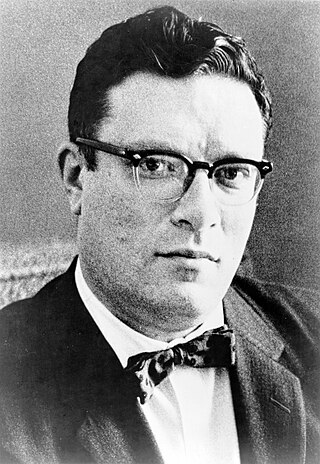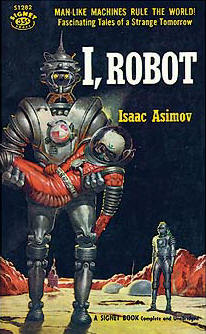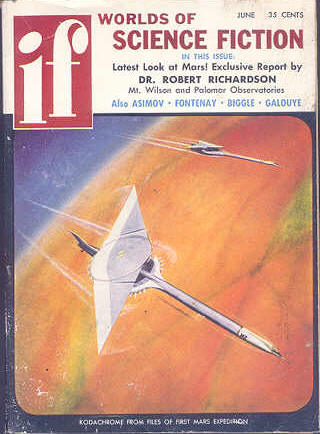
Isaac Asimov was an American writer and professor of biochemistry at Boston University. During his lifetime, Asimov was considered one of the "Big Three" science fiction writers, along with Robert A. Heinlein and Arthur C. Clarke. A prolific writer, he wrote or edited more than 500 books. He also wrote an estimated 90,000 letters and postcards. Best known for his hard science fiction, Asimov also wrote mysteries and fantasy, as well as popular science and other non-fiction.

The Three Laws of Robotics are a set of rules devised by science fiction author Isaac Asimov, which were to be followed by robots in several of his stories. The rules were introduced in his 1942 short story "Runaround", although similar restrictions had been implied in earlier stories.

Stanley Grauman Weinbaum was an American science fiction writer. His first story, "A Martian Odyssey", was published to great acclaim in July 1934; the alien Tweel was arguably the first character to satisfy John W. Campbell's challenge: "Write me a creature who thinks as well as a man, or better than a man, but not like a man." Weinbaum wrote more short stories and a few novels, but died from lung cancer less than a year and a half later.
"Blind Alley" is a science fiction short story by American writer Isaac Asimov. It was first published in the March 1945 issue of Astounding Science Fiction, and later included in the collection The Early Asimov (1972).
"Reason" is a science fiction short story by American writer Isaac Asimov, first published in the April 1941 issue of Astounding Science Fiction and collected in I, Robot (1950), The Complete Robot (1982), and Robot Visions (1990). It is part of Asimov's Robot series, and was the second of Asimov's positronic robot stories to see publication.
This is a bibliography of the books written or edited by Isaac Asimov, arranged alphabetically. Asimov was a prolific author, and he engaged in many collaborations with other authors. This list may not yet be complete. The total number of books listed here is over 500. Asimov died in 1992 at age 72; a small number of his books were published posthumously.

"The Deep" is a science fiction novelette by American writer Isaac Asimov. It was written in July 1952 and first published in the December 1952 issue of Galaxy Science Fiction. The story subsequently appeared in the Asimov collections The Martian Way and Other Stories (1955) and The Best of Isaac Asimov (1973). In In Memory Yet Green, Asimov wrote that his motive in writing the story was to deliberately test whether one could do anything in science fiction, so he invented a society in which mother love was considered obscene.
"Shah Guido G." is a science fiction short story by American writer Isaac Asimov. It was first published in the November 1951 issue of Marvel Science Fiction and reprinted in the 1975 collection Buy Jupiter and Other Stories, where Asimov explains his love of puns. It is an example of a shaggy dog story, as indicated by the title.
"Victory Unintentional" is a humorous science fiction short story by American writer Isaac Asimov, published in the August 1942 issue of Super Science Stories and included in the collections The Rest of the Robots (1964) and The Complete Robot (1982).
"Not Final!" is a science fiction short story by American writer Isaac Asimov, originally published in the October 1941 issue of Astounding Science Fiction, and included in the 1972 collection The Early Asimov. Its sequel, "Victory Unintentional", is a robot story. These are two of the few stories by Asimov to postulate non-human intelligences in the Solar system.

Jupiter, the largest planet in the Solar System, has appeared in works of fiction across several centuries. The way the planet has been depicted has evolved as more has become known about its composition; it was initially portrayed as being entirely solid, later as having a high-pressure atmosphere with a solid surface underneath, and finally as being entirely gaseous. It was a popular setting during the pulp era of science fiction. Life on the planet has variously been depicted as identical to humans, larger versions of humans, and non-human. Non-human life on Jupiter has been portrayed as primitive in some works and more advanced than humans in others.

Saturn has made appearances in fiction since the 1752 novel Micromégas by Voltaire. In the earliest depictions, it was portrayed as having a solid surface rather than its actual gaseous composition. In many of these works, the planet is inhabited by aliens that are usually portrayed as being more advanced than humans. In modern science fiction, the Saturnian atmosphere sometimes hosts floating settlements. The planet is occasionally visited by humans and its rings are sometimes mined for resources.

"Everest" is a science fiction short story by American writer Isaac Asimov. It was first published in the December 1953 issue of Universe Science Fiction and reprinted in the 1975 collection Buy Jupiter and Other Stories. Asimov wrote the story in one sitting while visiting the Chicago, Illinois editorial offices of Universe on 7 April 1953.

"Founding Father" is a science fiction short story by American writer Isaac Asimov. It was first published in the October 1965 issue of Galaxy Science Fiction, and reprinted in the 1975 collection Buy Jupiter and Other Stories. It was inspired by a cover painting of a space-helmeted face backed by several crosses, provided by the magazine's editor, Frederik Pohl.
"Each an Explorer" is a science fiction short story by American writer Isaac Asimov. It was written in June 1956 and first published in issue #30 of Future Science Fiction. It was also reprinted in the 1975 collection Buy Jupiter and Other Stories.

"Does a Bee Care?" is a science fiction short story by American writer Isaac Asimov. It was first published in If: Worlds of Science Fiction in June 1957, and reprinted in the 1975 collection Buy Jupiter and Other Stories. Gold Key Comics also published a comic book version of the story in 1976 in #4 of the four issue science fiction series Starstream: Adventures in Science Fiction. It also appeared in 1976's Questar: Illustrated Science Fiction Classics, published by Golden Press and adapted by A. Moniz with artwork from Jack Abel and in 1975 in Buy Jupiter and Other Stories.
"Exile to Hell" is a science fiction short story by American writer Isaac Asimov. It appeared in the May 1968 issue of Analog Science Fiction and Fact and was included in the 1975 collection Buy Jupiter and Other Stories.
2430 A.D. is a science fiction short story by the American writer Isaac Asimov. It first appeared in the October 1970 issue of Think, the IBM house magazine, and was reprinted in Asimov's 1975 collection Buy Jupiter and Other Stories.
"The Greatest Asset" is a science fiction short story by American writer Isaac Asimov. It was written as a counterpoint to his story "2430 A.D." with the intention of refuting, rather than illustrating, the same quotation by writer and social commentator J. B. Priestley. It was published in the January 1972 issue of Analog and reprinted in the 1975 collection Buy Jupiter and Other Stories.
"Silly Asses" is a science fiction short story by American writer Isaac Asimov. It was published in the February 1958 issue of Future Science Fiction, after having been twice rejected by other outlets. It was subsequently included in the collections Have You Seen These? in 1974 and Buy Jupiter and Other Stories in 1975. It runs to less than two pages in paperback.








